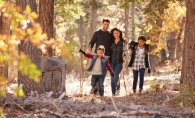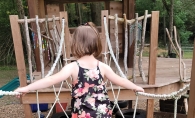After a long winter, spring is finally making an appearance in Minnesota. The snow is melting, birds are chirping, and more people are venturing out of their homes to enjoy the outdoors. For those who are looking for ways to embrace the season, the St. Croix Valley has an abundance of parks, state trails and nature centers.
One of the area’s newest park regions is the Brown’s Creek State Trail, which officially opened to the public in October, 2014. The park land, which the Minnesota DNR and Washington County purchased in 2012, follows a railroad route that the Minnesota Zephyr used more than 20 years ago.
“Brown’s Creek and the Gateway are destination trails,” Jan Wolff, central regional manager of the Minnesota DNR Division of Parks and Trails, says. “They are very close to many people, highly used and easily accessible. They are beautiful trails that help people connect with nature while promoting healthier and happier lifestyles.”
The Brown’s Creek State Trail runs 5.9 miles and connects Stillwater and the St. Croix River shoreline with the Gateway State Trail. Along the trail, nature and fitness enthusiasts are able to enjoy a variety of non-motorized activities such as biking, rollerblading, walking, horseback riding and even cross-country skiing.
Coinciding with National Trails Day, Brown’s Creek State Trail will have its official ribbon-cutting ceremony and dedication on June 6, marking its first season.
“People are excited about it. It’s a really nice trail with beautiful habitats,” Linda Radimecky, Afton State Park area interpretive naturalist, says. She considers it an excellent development and expects the area to resonate with the community. “The trail is so close for people that it allows them to bike [and explore the area].”
Near Stillwater is William O’Brien State Park and further south down the St. Croix River is Afton State Park and the Carpenter St. Croix Valley Nature Center in Hastings, where visitors can explore beautiful scenery and gain knowledge from a variety of educational programs.
Settled in the 1600s during a peak time for fur trading, but officially opening in 1947, William O’Brien State Park covers 2,200 acres on the banks of the St. Croix River and hosts more than 270,000 annual visits. The St. Croix River floodplain, oak-hickory forests, white pines, oak savanna, upland prairie and rolling meadows give home to variety of wildlife. As one of the nation’s best canoeing rivers, the St. Croix River offers another exciting way to enjoy the sights and sounds of the park.
Opened in 1969, Afton State Park is 1,620 acres of outdoor fun. With more than 190,000 visitors per year and more than 11,000 overnight visitors, Afton has something for everyone. Cut by profound ravines that drop 300 feet to the river, the park offers wooded forests, pine plantations, prairies and oak savannas. During the warmer months, wildflowers abound, from woodland ephemerals to blazing stars.
At the park, bird aficionados may find hawks and waterfowl on the St. Croix flyway, bluebirds and meadowlarks in the grasslands, or migratory birds in the floodplain. On the ground, guests may spot deer, foxes and wild turkeys.
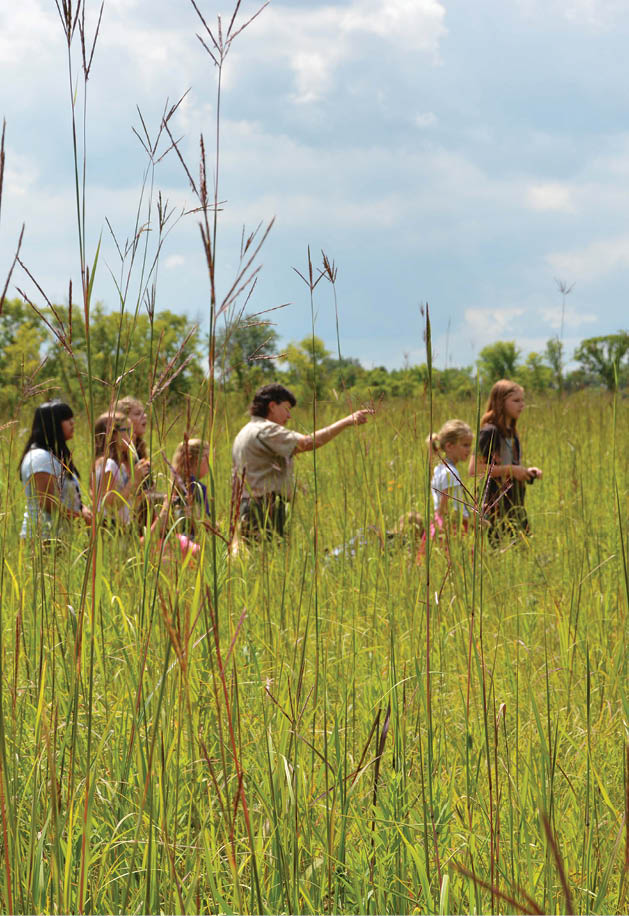
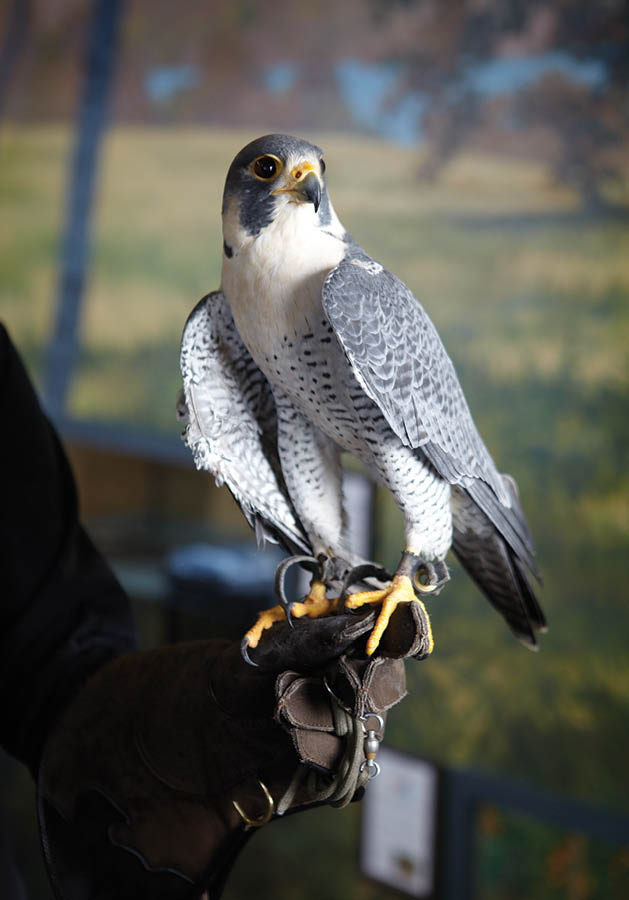
(Left: Exploration at Afton State Park. Right: An injured peregrine falcon)
A favorite aspect of the Afton State Park trail is its dual tread way. “The trail is great for multi-use,” says Radimecky. “Everything from rollerblading and biking to running is possible on the paved side, while the western half of the trail is made for horseback riding.”
Park visitors may also enjoy camping in one of the four rental cabins that are available year-round. The cabins include heat and electricity for those long winter nights, have nature-themed names, such as Bluebird, Big Bluestem and Bur Oak; two of the four are wheelchair accessible and sleep five to six people. Each campsite includes picnic tables and fire rings with grills. As a safety precaution, the park does not allow people to bring in their own firewood or burn candles or other open flames inside tents or cabins.
Another popular destination is the Carpenter St. Croix Valley Nature Center, which offers more than 700 acres of wooded and prairie land.
“We want nature to be accessible to everybody,” says Jennifer Vieth, executive director of the center.
More than 25,000 people visit the Carpenter Nature Center annually and roughly 7,000 of those are K-12 students who visit during school trips or are being introduced to nature through the center’s educational programs.
“A very popular activity of ours is the ‘making maple syrup’ program, which usually ends in March, but some years we are still tapping trees in April,” Vieth says. “It’s an excellent activity because kids get to taste the sap right out of the tree, as well as the finished maple syrup.”
Another youth activity at Carpenter Nature Center is the Minnesota Starwatch program with WCCO Radio meteorologist Mike Lynch. Lynch will run through the stories of the constellations and how to spot them. “He also uses a giant telescope to look at nebulae, star clusters, galaxies and more from other planets,” Vieth says. “It’s really fun.”
Fitness enthusiasts may enjoy the Apple Blossom Races, which include a 5K, 10K and half marathon that take place at St. Croix Bluffs Regional Park, three miles north of the Carpenter Nature Center on County Road 21, and a 2K Fun Run in May that starts at the Carpenter Nature Center.
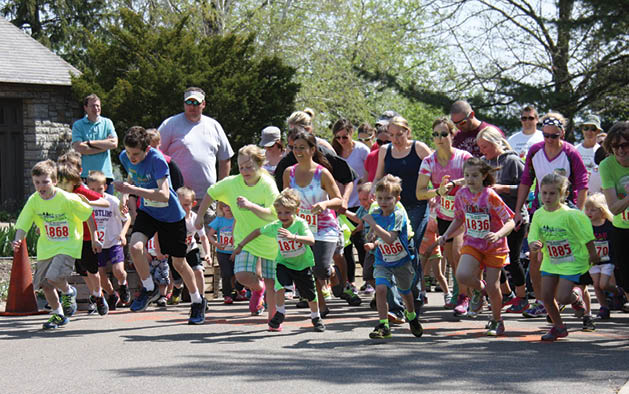
(Racers take off running at the annual Apple Blossom Races at St. Croix Bluffs Regional Park and the Carpenter Nature Center.)
“We will be celebrating our 30th annual Apple Blossom Races this year,” Vieth says. “The half marathon runs past local orchards, which are usually in full bloom at this time of year, so you can smell all of the apple blossoms while running.”
The event initially started as a fundraiser for the center and has grown into much more. “[The races] have become part of our mission to get people out in nature and stay physically fit and active,” Vieth says. “It’s great at the end of the half marathon when you get to see the faces of each runner light up when our board members presents them with a race medallion. It is a huge accomplishment.”
Most recently, the center joined the Project Owlnet program, which monitors owl population trends by setting up mist nets and banding the owls, mainly the Saw-whet owl, to see where they move. One evening, the center was surprised to find a small Saw-whet owl in their net.
“Most owls are nomadic and move depending on where the food sources are,” Vieth says. “We caught a feisty little owl in our net that flew from Prince Albert, Saskatchewan, to the nature center, which is a distance of over 821 miles. The fascinating part is that she was very small, only weighing [the equivalent of] eight Oreo cookies. The owls have much more predictable flight patterns than previously thought and some even travel down to Georgia.”
On the Wisconsin side of the river, day explorers can observe wildlife while hiking the many valleys and bluffs that surround Willow River State Park and Kinnickinnic State Park near Hudson, Wisconsin.
Willow River State Park has much to offer nature enthusiasts with 120 family campsites, a nature center, gift shop, boat launch area and three handicap-accessible fishing piers. Visitors may hike 13 miles of trails that vary in level of difficulty and feature Willow Falls and scenic overlooks of the river valley. For water enthusiasts, Little Falls Lake offers canoeing, kayaking, sculling and sailing. There is even a swimming area to cool off in during the warm summer months.
Established in 1972, Kinnickinnic State Park consists of 45 acres of donated land from Carl and Alice Pemble, Homer and Mildred Creswell, and George and Wilma Richter. Offering more than six miles of hiking trails, limestone cliffs and white pines, Kinnickinnic State Park is busy with wildlife. Visitors have the opportunity to view more than 140 species of birds, including ringneck pheasants, partridge and bald eagles, and mammals such as raccoons, mink and even beavers. The Kinnickinnic River is a class-one fly-fishing stream and the sand delta and scenic river views create a majestic setting.
While traveling through the valley, whether it is on Brown’s Creek State Trail or one of the many nature parks and trails, area residents are sure to find a multitude of activities to enjoy in the great outdoors – whether they venture out this spring, while the sun shines and the landscape bursts into color, or any time throughout the year.
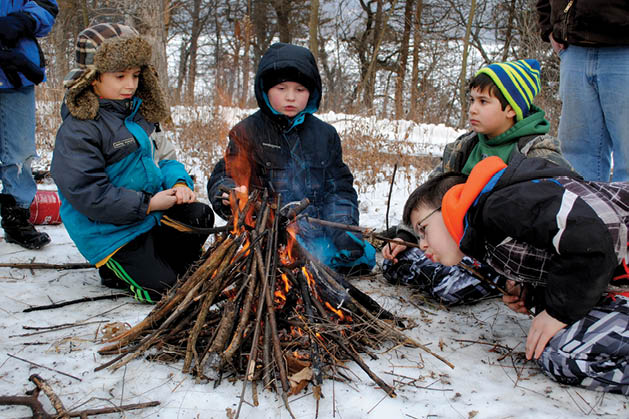

(Left: Children learn about winter survival at the Carpenter Nature Center. Right: The Afton State Park opened its first public yurt in February. A yurt is an enclosed camping structure that includes battery-powered lanterns, wood stove, and an outdoor fire pit.)
Visit dnr.state.mn.us for detailed map and trail information.








